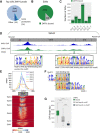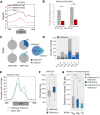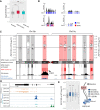ZNF91 deletion in human embryonic stem cells leads to ectopic activation of SVA retrotransposons and up-regulation of KRAB zinc finger gene clusters
- PMID: 33722937
- PMCID: PMC8015857
- DOI: 10.1101/gr.265348.120
ZNF91 deletion in human embryonic stem cells leads to ectopic activation of SVA retrotransposons and up-regulation of KRAB zinc finger gene clusters
Abstract
Transposable element (TE) invasions have shaped vertebrate genomes over the course of evolution. They have contributed an extra layer of species-specific gene regulation by providing novel transcription factor binding sites. In humans, SINE-VNTR-Alu (SVA) elements are one of three still active TE families; approximately 2800 SVA insertions exist in the human genome, half of which are human-specific. TEs are often silenced by KRAB zinc finger (KZNF) proteins recruiting corepressor proteins that establish a repressive chromatin state. A number of KZNFs have been reported to bind SVAs, but their individual contribution to repressing SVAs and their roles in suppressing SVA-mediated gene-regulatory effects remains elusive. We analyzed the genome-wide binding profile for ZNF91 in human cells and found that ZNF91 interacts with the VNTR region of SVAs. Through CRISPR-Cas9-mediated deletion of ZNF91 in human embryonic stem cells, we established that loss of ZNF91 results in increased transcriptional activity of SVAs. In contrast, SVA activation was not observed upon genetic deletion of the ZNF611 gene encoding another strong SVA interactor. Epigenetic profiling confirmed the loss of SVA repression in the absence of ZNF91 and revealed that mainly evolutionary young SVAs gain gene activation-associated epigenetic modifications. Genes close to activated SVAs showed a mild up-regulation, indicating SVAs adopt properties of cis-regulatory elements in the absence of repression. Notably, genome-wide derepression of SVAs elicited the communal up-regulation of KZNFs that reside in KZNF clusters. This phenomenon may provide new insights into the potential mechanisms used by the host genome to sense and counteract TE invasions.
© 2021 Haring et al.; Published by Cold Spring Harbor Laboratory Press.
Figures





Similar articles
-
An evolutionary arms race between KRAB zinc-finger genes ZNF91/93 and SVA/L1 retrotransposons.Nature. 2014 Dec 11;516(7530):242-5. doi: 10.1038/nature13760. Epub 2014 Sep 28. Nature. 2014. PMID: 25274305 Free PMC article.
-
The Role of SINE-VNTR-Alu (SVA) Retrotransposons in Shaping the Human Genome.Int J Mol Sci. 2019 Nov 27;20(23):5977. doi: 10.3390/ijms20235977. Int J Mol Sci. 2019. PMID: 31783611 Free PMC article.
-
ZNF91 is an endogenous repressor of the molecular phenotype associated with X-linked dystonia-parkinsonism (XDP).Proc Natl Acad Sci U S A. 2024 Aug 13;121(33):e2401217121. doi: 10.1073/pnas.2401217121. Epub 2024 Aug 5. Proc Natl Acad Sci U S A. 2024. PMID: 39102544 Free PMC article.
-
Evolution of KRAB-containing zinc finger proteins and their roles in species evolution.Yi Chuan. 2016 Nov 20;38(11):971-978. doi: 10.16288/j.yczz.16-056. Yi Chuan. 2016. PMID: 27867147 Review.
-
Transposable Elements, Polydactyl Proteins, and the Genesis of Human-Specific Transcription Networks.Cold Spring Harb Symp Quant Biol. 2015;80:281-8. doi: 10.1101/sqb.2015.80.027573. Epub 2016 Jan 13. Cold Spring Harb Symp Quant Biol. 2015. PMID: 26763983 Free PMC article. Review.
Cited by
-
Transposable elements drive the evolution of metazoan zinc finger genes.Genome Res. 2023 Aug;33(8):1325-1339. doi: 10.1101/gr.277966.123. Epub 2023 Sep 15. Genome Res. 2023. PMID: 37714714 Free PMC article.
-
Mini-heterochromatin domains constrain the cis-regulatory impact of SVA transposons in human brain development and disease.Nat Struct Mol Biol. 2024 Oct;31(10):1543-1556. doi: 10.1038/s41594-024-01320-8. Epub 2024 Jun 4. Nat Struct Mol Biol. 2024. PMID: 38834915 Free PMC article.
-
Potential role of KRAB-ZFP binding and transcriptional states on DNA methylation of retroelements in human male germ cells.Elife. 2022 Mar 22;11:e76822. doi: 10.7554/eLife.76822. Elife. 2022. PMID: 35315771 Free PMC article.
-
G-quadruplexes in an SVA retrotransposon cause aberrant TAF1 gene expression in X-linked dystonia parkinsonism.Nucleic Acids Res. 2024 Oct 28;52(19):11571-11586. doi: 10.1093/nar/gkae797. Nucleic Acids Res. 2024. PMID: 39287133 Free PMC article.
-
Genetic features and genomic targets of human KRAB-zinc finger proteins.Genome Res. 2023 Aug;33(8):1409-1423. doi: 10.1101/gr.277722.123. Epub 2023 Sep 20. Genome Res. 2023. PMID: 37730438 Free PMC article.
References
Publication types
MeSH terms
Substances
LinkOut - more resources
Full Text Sources
Other Literature Sources
Molecular Biology Databases
Research Materials
